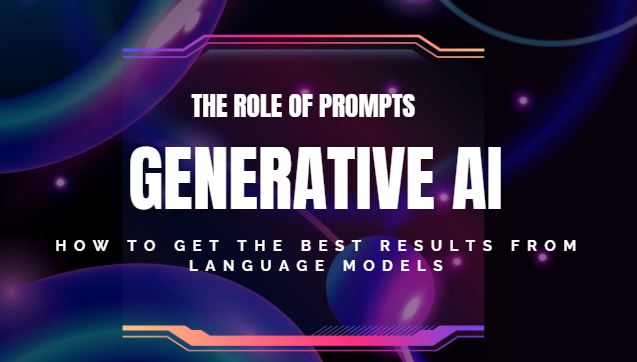
In the world of Generative AI, especially with models like GPT-4, the concept of a prompt plays a critical role in driving the quality and relevance of the output. A prompt serves as the input that guides an AI model, determining everything from the tone and style to the depth of content generated. Understanding how to craft effective prompts can unlock the full potential of these models, allowing users to generate more accurate, creative, and insightful content.
In this blog, we’ll explore the significance of prompts in generative AI and provide actionable tips for designing effective prompts to maximize results.
What is a Prompt in Generative AI?
At its core, a prompt is a textual instruction or question that you provide to an AI model to generate a response. In the case of large language models like GPT-4, the prompt is the foundation upon which the AI builds its output. Think of it as the blueprint—whatever you ask for, the AI will attempt to deliver.
For example:
- Simple Prompt: “What is the capital of France?”
- AI Output: “The capital of France is Paris.”
- Creative Prompt: “Write a short story about a dragon that loves flowers.”
- AI Output: “Once upon a time, in a land far away, there lived a dragon named Flora who adored flowers…”
As you can see, the structure and detail of your prompt directly influence the model’s response. A well-crafted prompt yields coherent, useful, and relevant answers, while a vague prompt may result in incomplete or off-target responses.
Why Are Prompts So Important?
Prompts are essential for two main reasons:
- Direction and Control: They determine the context, tone, and focus of the response. You can fine-tune the model’s output by providing clear instructions or examples in the prompt.
- Efficiency: A properly framed prompt can help the model produce accurate answers quickly, without the need for multiple attempts. This saves time and effort in applications like content creation, programming assistance, or customer support.
Types of Prompts
There are different ways to craft prompts, and each serves a unique purpose depending on the task at hand.
Let’s look at a few common types:
- Instruction-Based Prompts:
- These prompts give explicit instructions for the AI to follow.
- Example: “Explain the concept of quantum physics in simple terms.”
- Question-Based Prompts:
- These prompts ask a specific question, prompting the model to provide an informative answer.
- Example: “What are the top 5 benefits of renewable energy?”
- Contextual Prompts:
- These include background information or context to guide the AI response.
- Example: “Given that solar energy is becoming more affordable, explain its future potential.”
- Zero-Shot, One-Shot, and Few-Shot Prompts:
- Zero-shot: No example is given, and the model is expected to answer based solely on the prompt.
- One-shot: One example is included to provide guidance.
- Few-shot: Multiple examples are given to clarify the task.
- Example (Few-shot): “Translate the following sentences into French: 1. I love coffee. 2. The sky is blue.”
How to Craft Effective Prompts for Generative AI
Now that we understand the importance of prompts, let’s look at some tips for creating the best prompts to get the most accurate and relevant outputs from AI models.
1. Be Specific and Clear
One of the most common mistakes is providing vague prompts. A general or ambiguous prompt will confuse the model, leading to irrelevant or incomplete responses. Instead, focus on being as clear and specific as possible.
- Example of a vague prompt: “Tell me about technology.”
- Example of a specific prompt: “Explain the impact of AI on healthcare innovation in 2024.”
The second example gives the model a clear focus, leading to a more useful and detailed output.
2. Define the Desired Format
If you have a preferred format for the response—such as bullet points, paragraphs, or lists—mention it in your prompt.
- Example Prompt: “List the top 3 reasons why businesses should use social media marketing, in bullet points.”
This helps the model deliver the content in the structure you expect, saving time in editing or formatting the result.
3. Provide Context Where Necessary
For more complex topics, it’s helpful to provide context to the AI. This ensures the model understands the background and can provide a more relevant answer.
- Example Prompt: “Given the recent advancements in renewable energy technology, explain the potential benefits of solar power in rural communities.”
By including the recent advancement context, the model can generate a more tailored and accurate response.
4. Experiment with Length
Sometimes, a short and direct prompt works perfectly. Other times, a longer and more detailed prompt may produce better results. Experiment with the length of your prompts to see what works best for the task at hand.
- Short Prompt Example: “Describe the effects of climate change.”
- Longer Prompt Example: “Describe the effects of climate change, focusing on rising sea levels, extreme weather patterns, and its impact on biodiversity.”
The longer prompt provides more direction, leading to a richer response.
5. Refine and Iterate
Don’t expect the perfect output on your first try. Prompt engineering is a process. Test different variations, refine the wording, and experiment with different structures to get the desired output.
Common Use Cases for Generative AI Prompts
Generative AI models like GPT-4 have a wide range of applications, and prompts are the driving force behind each of them. Here are some common use cases where crafting effective prompts can make all the difference:
- Content Creation: Writing blogs, articles, product descriptions, or social media posts.
- Programming Assistance: Generating or debugging code, creating algorithms.
- Customer Support: Automating responses to common inquiries.
- Data Analysis: Summarizing reports or analyzing complex data sets.
- Creative Writing: Storytelling, poetry, or scriptwriting.
In each of these cases, the quality of the prompt will heavily influence the final output, underscoring the importance of thoughtful prompt design.
Learn Machine Learning and Generative AI with MITSDE
For those aspiring to excel in the fields of machine learning and generative AI, MIT School of Distance Education (MITSDE) offers a cutting-edge curriculum designed to provide in-depth knowledge and practical skills. MITSDE’s programs cover the foundational concepts of machine learning algorithms, large language models, and AI applications, enabling learners to stay ahead in this rapidly advancing domain. With industry-relevant coursework, expert faculty, and real-world projects, MITSDE ensures that students are equipped to tackle complex challenges in AI and machine learning.
Whether you’re looking to deepen your understanding of data science, optimize AI-driven models, or explore generative AI for business, MITSDE provides the tools and support needed to succeed in today’s competitive tech landscape.
Conclusion: The Power of a Well-Crafted Prompt
In the world of Generative AI, a well-crafted prompt is the key to unlocking the true potential of models like GPT-4. Whether you’re generating content, writing code, or automating tasks, the prompt you use will determine the quality, relevance, and accuracy of the AI’s output.
By being specific, clear, and providing context where necessary, you can guide the model to produce insightful and creative responses that match your needs. With some experimentation and refinement, mastering prompt engineering will help you get the best results from generative AI models every time.

